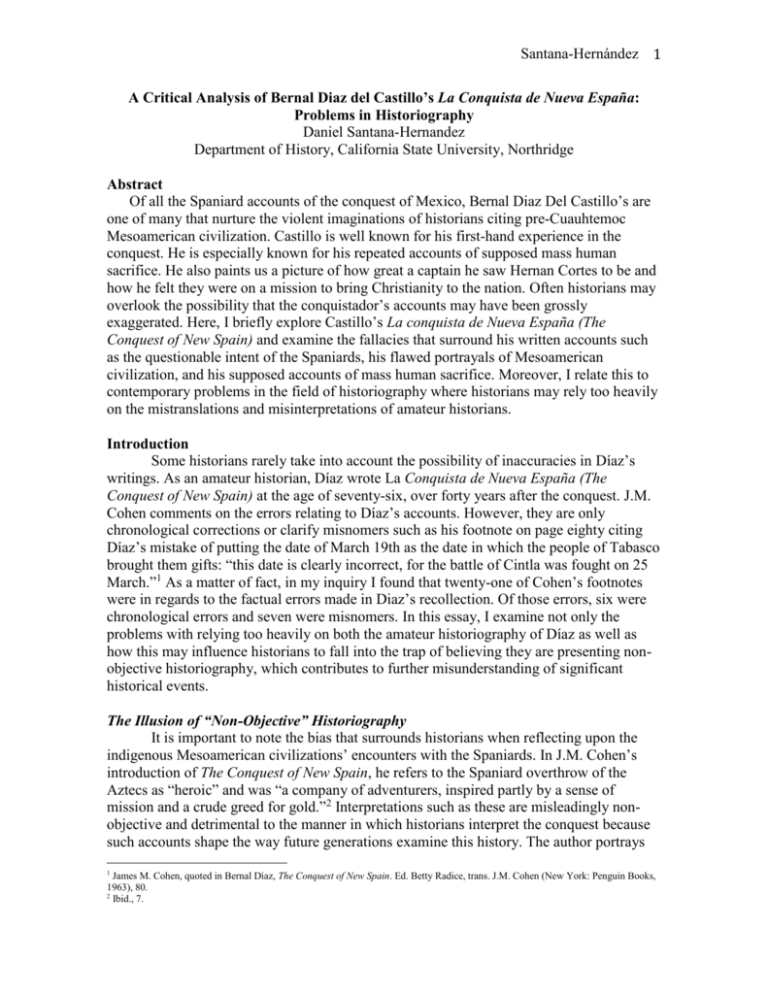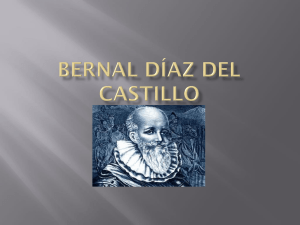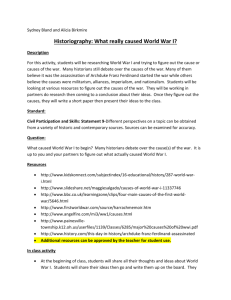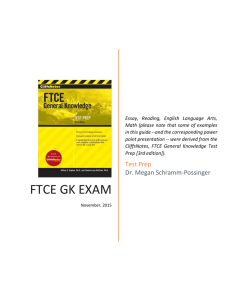Santana-Hernández A Critical Analysis of Bernal Diaz del Castillo`s
advertisement

Santana-Hernández 1 A Critical Analysis of Bernal Diaz del Castillo’s La Conquista de Nueva España: Problems in Historiography Daniel Santana-Hernandez Department of History, California State University, Northridge Abstract Of all the Spaniard accounts of the conquest of Mexico, Bernal Diaz Del Castillo’s are one of many that nurture the violent imaginations of historians citing pre-Cuauhtemoc Mesoamerican civilization. Castillo is well known for his first-hand experience in the conquest. He is especially known for his repeated accounts of supposed mass human sacrifice. He also paints us a picture of how great a captain he saw Hernan Cortes to be and how he felt they were on a mission to bring Christianity to the nation. Often historians may overlook the possibility that the conquistador’s accounts may have been grossly exaggerated. Here, I briefly explore Castillo’s La conquista de Nueva España (The Conquest of New Spain) and examine the fallacies that surround his written accounts such as the questionable intent of the Spaniards, his flawed portrayals of Mesoamerican civilization, and his supposed accounts of mass human sacrifice. Moreover, I relate this to contemporary problems in the field of historiography where historians may rely too heavily on the mistranslations and misinterpretations of amateur historians. Introduction Some historians rarely take into account the possibility of inaccuracies in Díaz’s writings. As an amateur historian, Díaz wrote La Conquista de Nueva España (The Conquest of New Spain) at the age of seventy-six, over forty years after the conquest. J.M. Cohen comments on the errors relating to Díaz’s accounts. However, they are only chronological corrections or clarify misnomers such as his footnote on page eighty citing Díaz’s mistake of putting the date of March 19th as the date in which the people of Tabasco brought them gifts: “this date is clearly incorrect, for the battle of Cintla was fought on 25 March.”1 As a matter of fact, in my inquiry I found that twenty-one of Cohen’s footnotes were in regards to the factual errors made in Diaz’s recollection. Of those errors, six were chronological errors and seven were misnomers. In this essay, I examine not only the problems with relying too heavily on both the amateur historiography of Díaz as well as how this may influence historians to fall into the trap of believing they are presenting nonobjective historiography, which contributes to further misunderstanding of significant historical events. The Illusion of “Non-Objective” Historiography It is important to note the bias that surrounds historians when reflecting upon the indigenous Mesoamerican civilizations’ encounters with the Spaniards. In J.M. Cohen’s introduction of The Conquest of New Spain, he refers to the Spaniard overthrow of the Aztecs as “heroic” and was “a company of adventurers, inspired partly by a sense of mission and a crude greed for gold.”2 Interpretations such as these are misleadingly nonobjective and detrimental to the manner in which historians interpret the conquest because such accounts shape the way future generations examine this history. The author portrays 1 James M. Cohen, quoted in Bernal Díaz, The Conquest of New Spain. Ed. Betty Radice, trans. J.M. Cohen (New York: Penguin Books, 1963), 80. 2 Ibid., 7. Santana-Hernández 2 the image of the Spaniards as a group of adventurers on a mission and destined to become heroes yet postscripts their intentions. The historical inaccuracy occurs in the fact that the Spaniards were not strictly adventurers. Díaz himself says in his accounts, after arriving to Cuba: “After spending three fruitless years in Tierra Firme and Cuba, about a hundred and ten of us, settlers from Tierra Firme or Spaniards who had come to Cuba but received no grant of Indians, decided to make an expedition to seek new lands in which to try our fortunes and find occupation.”3 This line not only serves to tell us that they are expanding to gain more riches and lands but also that they plan to do so through the process of enslavement. Evidently, it was due to the fact that a number of Spaniards were dissatisfied of having left their homes and insecure about not having any great possessions. This is a word to the wise to those who romanticize the Spaniard’s journey as a simple exploration. As mentioned earlier, there is something very problematic in the way the conquest of Mexico has been portrayed. “Now it is a fact,” says Díaz, “that we afterwards heard, that the Indians’ ancestors had prophesized that men with beards would come from the direction of the sunrise and rule over them.”4 Such portrayals of history have been so repeated to the extent it seems foolish to question the accuracy of Díaz’s writings. In the second chapter of A History of Latin America, the author footnotes his personal opinion as to why he believes it is preposterous for one to denounce the claim that the natives thought Hernán Cortez was Quetzalcoatl: “This skeptical point of view strikes us as ahistorical. History records numerous legends that foretell the return of redeemer-gods or –kings.”5 First off, the writer insults and intimidates those who question the event, calling them “ahistorical” according to “us”. The use of the word “us” in this sentence is erroneous because it seeks to generalize historians in general. It is also an intimidating factor because it makes those who question feel they are committing historical blasphemy and are thus arrogant according to an imaginary council of great historians. Secondly, the writer takes the argument way out of context. He cites events in history as evidence to the possibility that there was a legend in regards to the return of a redeemer-god. First off, the initial argument is that it is erroneous to fully believe that “The conquistador Cortes appears to have been identified with the god [Quetzalcoatl] himself or with his emissary.”6 The argument never questioned the existence of the legend. The argument is simply in disagreement with the idea that the natives perceived Cortes to be Quetzalcoatl or perceiving the Spaniards to be the fulfillers of that actual prophecy. The author’s arguments become ever more ridiculous, begging the question that “If medieval Germans could believe in the return of the emperor Frederick Barbarossa, and if Renaissance Portuguese could believe in the return of King Sebastian, why could not the Aztecs believe in the return of the god-king Quetzalcoatl?”7 Such an argument ignores the question altogether and fails to respond to the inquiry of skeptics. After having read the initial accounts of Castillo, I rarely found any direct reference supporting the claim of natives believing the Spaniards to be gods. Simply put, Díaz said the Spaniards were the men that the natives prophesized would come conquer their lands.8 Díaz supposedly quotes Moctezuma twice on this: “He ended by saying that we must truly 3 Ibid., 16. Ibid., 35. 5 Benjamin Keen and Keith Haynes. A History of Latin America, 8th ed. (New York: Oxford University Press, 2009), 62. 6 Ibid. 7 Ibid. 8 James M. Cohen, quoted in Díaz, The Conquest of New Spain, 35. 4 Santana-Hernández 3 be the men about whom his ancestors had long ago prophesied, saying that they would come from the direction of the sunrise to rule over these lands.”9 Throughout the recollection I found no direct quote in which he tells us of the natives calling them gods. He does say, however, that they referred to them as “teules.”10 Supposedly teules is the Nahua word for “gods”, according to Cohen.11 It is, according to historian Camilla Townsend, the plural word for the word god, which is supposedly “teotl” in Nahuatl.12 Díaz himself was unsure about the meaning of the word. He tells us, after they had detained the Mexican tribute collectors at the land of the Totonacs: “From that moment they called us Teules, which means gods or demons.”13 We will really never know for sure if this specifically referred to the Spaniards as gods. Townsend brings up the fact that the natives had to call the Spaniards something and that their labeling, as teules, was something perhaps influenced by la Malinche,14 the Christianizing of the natives, or perhaps even a grave mistranslation.15 Towards a more Contemporary, Critical, and Nahua-Literate Historiography To reiterate my point, I found that there were many false portrayals of Mesoamerican civilization in Díaz’s writings. The structure of the Aztec government as a kingdom, although obviously not in the same sense as Europeans ruled over theirs, is an erroneous choice of words. There are also many incidents in which he portrayed the Mexican women they were given as prostitutes. On a number of occasions they found these women were not sent to them for that purpose. I also wanted to note the supposed direct quotes from Moctezuma and other natives who seemed to dread or welcome the coming of the Spaniards. These misconceptions will be pointed out not simply for the sake of being critical but also to breathe oxygen into the other side of the story that otherwise remains suffocated under the weight of the popular side. Understandably, Díaz refers to the structure of Mehxico as a kingdom. It is really one of the only forms of government he has learned about or grown accustomed to. It is erroneous, however, to continue with such terminology to this day considering the wide variety of government structures we learn about in overall world history. Díaz constantly refers to Moctezuma and other elected officials as “lords” of the Mexica confederation.16 Unlike Europeans, the so-called rulers in Mexico, called tlactoanis, had a more complex system of administering their governments requiring consultation of other elderly authorities as opposed to unilateral rule.17 This is hinted in Díaz’s writings where he views Moctezuma consulting with his counsel of elders regarding their collective decision of possibly having to surrender to the Spaniards as opposed to making this decision himself.18 Furthermore, the portrayal of the nation as a male kinship is false and misleading. As 9 Ibid., 220. Ibid., 112. 11 Ibid. 12 Camilla Townsend,"Burying the White Gods: New Perspectives on the Conquest of Mexico." American Historical Review 108, no. 3 (June 2003): 670. 13 Díaz, The Conquest of New Spain, 35. 14 I must clarify that here I am referring to la Malinche as merely acting as an ally of Cortez as opposed to objective historians that seek to label her as a “traitor,” which is a completely different issue that is addressed in various other scholarly debates on la Malinche and therefore I shall not delve into it here. 15 Townsend, "Burying the White Gods," 670-671. 16 Díaz, The Conquest of New Spain, 217. 17 Susan Kellogg, "The woman's room: Some aspects of gender relations in Tenochtitlan in the late pre-Hispanic period." Ethnohistory 42, no. 4 (Fall 1995): 565. 18 Díaz, The Conquest of New Spain, 264. 10 Santana-Hernández 4 historian Susan Kellog cites, Aztec women served many administrative roles in society as well as being given the role of tlactoani but were named tlatocacihuatl or cihuatecutli.19 A nonverbal misconception is also noticeable in The Conquest of New Spain. I am speaking about the degradation and secondary roles given to women. It is the idea that after the natives lost a battle or welcomed the Spaniards, they would give them women for use as sexual objects as a form of courtesy. This was not true at all times. In one event, Díaz is disappointed to see female elders accompany a group of representatives: “He decided therefore to send forty men with supplies of fowls, bread, and fruit, four miserable-looking old women…from their appearance we supposed that these Indians came with peaceful intentions.”20 However, as we later find out these women who were sent were not prostitutes but women delegated to make food for the starving conquistadors.21 Such portrayal of women is characteristic of the Spaniard practice of machismo, which seeks to establish male dominance and place women in secondary roles, especially sex objects.22 Díaz evidently perpetuated his views into mistranslations. On Human Sacrifice Of all the sacred cows to kick, none tends to entertain the ears more than that of Diaz’s accounts of human sacrifice. This is the one feature that has credited to Díaz’s fame. However, many of the accounts have been criticized either because they may have been exaggerated or been seemingly impossible. Nonetheless, there have been historians that have boldly decided to put their foot in the Spaniards’ mouth. In this inquiry, we also find what purpose such stories accomplish. In Díaz’s accounts of the conquest, we find similar and repetitive stories of mass human sacrifice. In fact, he tells us the exact same scenarios of blood-stained altars, walls, hearts laid beside idols, and chests cut open.23 He notes his repetitiveness so much so he even tells the reader: “But the reader will be tired of this constant story of sacrifices, and I will mention them no more.”24 However, he continues to do so in the same manner on pages 138, 173, 202, 205, 229, 256, 279, 323, 346, 347, 348, and so many other pages I dare to not mention them all. Indeed it almost looks like a scene coming out of a horror movie. In a controversial World Press Review article in 1992, Peter Hassler published The Lies of the Conquistadors. He specifically quotes Díaz on his supposed witnessing of watching one of his comrades getting sacrificed atop a temple. “After they had danced the papas laid them down on their backs on some narrow stones of sacrifice and, cutting open their chests, drew out their palpitating hearts which they offered to the idols before them.”25 Hassler argues that for Díaz to have witnessed such an event was impossible. The Spaniards had just retreated from one of their clashes with the Aztecs to their campgrounds at least three to four miles away.26 For Díaz to have witnessed such an event would be impossible. 19 Kellogg, "The Woman's Room," 565. Díaz, The Conquest of New Spain, 161. 21 Ibid., 165. 22 David E. Stannard, American Holocaust: The Conquest of the New World (New York: Oxford University Press, 1992), 84. 23 Díaz, The Conquest of New Spain, 104. 24 Ibid., 106. 25 Ibid., 387. 26 Peter Hassler, “The Lies of the Conquistadors.” World Press Review 39, no.12 (December 1992): 28. 20 Santana-Hernández 5 The question then arises that if the accounts were exaggerated and perhaps even fabricated: what would the purpose be? Conquistador Pedro de Cieza de Leon offered his opinion: “These and other things are the testimony we Spaniards raise against these Indians…endeavoring by these things we tell of them to hide our own shortcomings and justify the ill treatment they have suffered at our hands…I am not saying that they did not make sacrifices…but it was not as it was told.”27 Evidently, the numbers, if one was to deduce that human sacrifice actually existed, were perhaps exaggerated. Discussion and Future Horizons As much as Díaz would like to convince us that his accounts are “true and wonderful” there is a great need for critical reflection of his accounts.28 This is not an attempt to rewrite history. Nor is this simply just to offer an alternative perspective to try to convince you that everything the Spaniards say are lies. The Conquest of New Spain is a fascinating narrative not simply because of its recollections but also because it has a great abundance of information where scholars can throw themselves into research. It draws on our curiosity because it tells us that the history of present-day Latin America is a mystery now more than ever. As a Chicano historian, this inspires my obligation to participate in such study. However, what the reader may also find noticeable is the lack of Chicana/o or Latina/o voices in the field of historiography that is able to ask such thought-provoking questions. This is thus a plea for Latinas/os to also delve into the field of historiography. We historians, regardless of our ethnicity or nationality, are aware that because of the flaws of the conquistadors this particular moment of history is both incomplete and partly erroneous. This report only scratches the surface of the unclear stories of the conquest. I have not spoken of the brutal incentive of gold that fed Cortez’s and other Spaniards’ wills to push into the city, intentional genocide, the various perspectives as to why some question if Cortez was really perceived as Quetzalcoatl, and I also have not gone into detail the perhaps grossly exaggerated phenomena of human sacrifice told by Díaz. This is a call for historians, all people for that matter, to not portray these Spaniard accounts as fully accurate knowing that there is no absolute certainty or lacks evidence backing up the validity of such claims. We know that as historians we have a great deal of work to accomplish whether it is to find facts questioning the validity of the Spaniard’s statements or perhaps even supporting them in an effort to discover the past. 27 28 Stannard, American Holocaust, 80. Cohen, quoted in Díaz, The Conquest of New Spain, 7. Santana-Hernández 6 Bibliography Diaz del Castillo, Bernal. The Conquest of New Spain. Translated by J. M. Cohen. Edited by Betty Radice. New York: Penguin Books, 1963. Hassler, Peter. “The Lies of the Conquistadors” World Press Review 39, no. 12 (December 1992): 28. Keen, Benjamin, and Haynes, Keith. A History of Latin America. 8th ed. New York: Oxford University Press, 2009. Kellogg, Susan. "The woman's room: Some aspects of gender relations in Tenochtitlan in the late pre-Hispanic period." Ethnohistory 42, no. 4 (Fall 1995): 563-576. Stannard, David E. American Holocaust: The Conquest of the New World. New York: Oxford University Press, 1992. Townsend, Camilla. “Burying the White Gods: New Perspectives on the Conquest of Mexico” American Historical Review 108, no. 3 (June 2003): 659-687.








